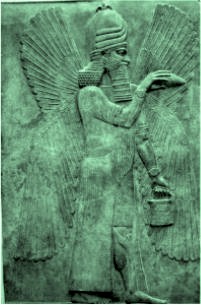 |
|
|
 |
 |
Up until only around 10,000 years ago, all humans lived as hunter-gatherers (with some communities persisting until this day). They generally lived in small, nomadic groups. Because the agricultural revolution dramatically lowered the energy expenditure to produce carbohydrates, and provided a reliable source of food, the advent of agriculture prompted the Neolithic Revolution. Access to food surplus led to the formation of permanent human settlements, the domestication of animals, and the use of metal tools. Within a few thousand years much of humanity had come to rely on a few starchy crops for the overwhelming bulk of their calories. The population expanded in areas given over to agricultural to the point that they could not be supported by a return to a nomadic hunter-gathering way of life.

You will reap as you sow.
In his book "Our Kind" Marvin Harris states:
In the earliest centers of agriculture and stockraising, people depended on rainfall to water their crops. As the population increased, they experimented with irrigation and began to fission off and colonize the drier parts of the region. Sumer, situated in the rainless but swampy and flood-prone deltaic zones of the Tigris-Euphrates, was settled in this manner. Confined at first to the margins of a natural watercourse, the Sumerians soon became totally dependent on irrigation to water their fields of wheat and barley, unknowingly trapping themselves into the final condition for the transition to statedom. As their would-be kings pressed for more taxes and more public labor, Sumer's commoners found that they lost the option to move out. How could they take the artificial waterways and their irrigated fields, gardens, and orchards, representing the investment of generations of labor, with them? To live away from the rivers, they would have to adopt a pastoral nomadic way of life for which they lacked the prerequisite skills and technology-
Archaeologists are not able to say exactly where and when in Sumer the transition took place. But by 4350 b.c., mud-brick structures with ramps and terraces called ziggurats, combining the function of fortress and temple, began to loom over the larger settlements. Like the mounds, tombs, megaliths, and pyramids found throughout the world, ziggurats attest to the presence of advanced chiefdoms capable of organizing large amounts of donated labor and were the forerunner of the great tower of Babylon, which was over 300 feet high, and of the Biblical tower at Babel. By 3500 b.c., there were streets, houses, temples, palaces, and fortifications covering several hundred acres at Uruk in Iraq. Perhaps the transition occurred there. If not, it took place at Lagash, Eridu, Ur, or Nippur, all flourishing as independent kingdoms by 3200 b.c.
Driven by the same internal pressures that sent chiefdoms to war, the Sumerian kingdom had one important advantage. Chiefdoms were likely to try to exterminate their enemies and to kill and eat their prisoners of war. Only states possessed the managerial know-how and the military might for extracting labor and resources from conquered people. By aggregating defeated populations into a peasant class, states rode an amplifying wave of territorial expansion. The more populous and productive they became, the greater their power to defeat and exploit additional peoples and territories. At various times after 3000 b.c., one or the other of the Sumerian kingdoms held sway over Sumeria. But other states soon formed farther upstream on the Euphrates. Under Sargon I, in 2350 b.c., one of them conquered all of Mesopotamia including Sumeria and lands extending from the Euphrates to the Mediterranean Sea. For the next 4,300 years it was one empire after another: Babylonian, Assyrian, Hyskos, Egyptian, Persian, Greek, Roman, Arabian, Ottoman, British. Our kind had created and mounted a wild beast that ate continents. Will we ever be able to tame this, our own creation, the way we tamed nature's sheep and goats?
|

Metabolic Transformations that Shaped Human Development
In order to fully understand our physical and nutritional needs, we need to appreciate the impact that our evolutionary past had on the development of our minds and bodies. It has been argued that two great metabolic transformations shaped the development of modern humans. In our early history we were intelligent and adaptive omnivores who exploited opportunities for a variety of food sources by an array of scavenging techniques. Many of our food sources had low nutritional value, and that which was of higher value was scarce and unreliable. The randomness of our nutritional assets led to an energy storage solution that is with us today. Our ability to store energy as fat and our inclination to gorge ourselves on fatty meat are a relic of that period in our development.
Given our foundation in this early metabolic construction, we underwent the first metabolic transformation at the beginning of the last ice age approximately 100,000 years ago. It was then that we transitioned from scavengers, to hunters of large game. Then again another metabolic adaptation occurred about 10,000 years ago with the development of agriculture.
In his paper Evolutionary Fitness, Dr. Arthur De Vany (Copyright 2005) writes that:
The second metabolic revolution, and arguably the most important revolution in the history of Homo sapiens, was the agricultural revolution beginning about 10,000 years ago in Asia and near the Mediterranean. Agriculture came later to Europe, perhaps only 6,000 or 2,000 years ago. Great Britain was still making its transition to agriculture at the time Caesar’s army entered around 100 BC. The paleo-anthropological evidence shows that with the agricultural revolution there was a decline in stature, cranial capacity, and muscularity, along with a general de-cline in health and nutrition. (How do they know our pre-agricultural ancestors were muscular? The bones are thick and dense and the points where muscles were attached are robust.) This metabolic revolution substituted routinized, repetitive work of grinding intensity and a diet of low variety and protein content for the metabolically varied physical activities of hunting and gathering and the enormous variety of food and high protein content of hunter-gatherer diets. Within a few thousand years much of humanity had come to rely on a few starchy crops for the overwhelming bulk of their calories. The repetitive work of agriculture and grain processing left their mark in the high incidence of arthritis that is found in the skeletons of our agriculturist ancestors.Even today, most of the third world lives on a few starchy crops and they exhibit the damage that a high carbohydrate diet with too little fresh plant and animal foods can inflict.
Those people who populate the areas where agriculture began earliest show what is called a Mediterranean physical type characterized, according to Webster, as medium or short stature, slender build and small heads. Third world children, living in rural, agricultural areas, live almost entirely on grains. They rarely eat fresh fruit or vegetables and eat meat even less often. They achieve less stature and test performance than urban children and suffer skeletal and dental deficiencies. It is easy to tell from the skeletons of our ancestors whether they were agriculturists or hunter-gatherers. The agriculturists have bad teeth, bone lesions, small and underdeveloped skeletons and small craniums compared to hunter-gatherers.The important metabolic revolutions to follow agriculture were the industrial and information revolutions. These energy-conserving revolutions lowered the level and variety of the metabolic challenges we face still more. The industrial revolution introduced milling of grains, a major factor in elevating the starch content of grain-based foods with a consequent rise in their insulin-elevating effect on human metabolism. In addition, the mineral and phytochemical content of grain-based foods were dramatically reduced. Our ancestors are us. It was only 10,000 years ago that agriculture changed the human lifeway from hunting and gathering to settled agriculture. And the dramatic decline in human energy expenditure of the industrial age occurred no more than 200 years ago. The information and television age is no more than two decades old. In this brief time span evolution has made few, if any, changes in what we inherited from the prior 3 million years.
|
|
|
 |
|
|
 |
|
|
 |
|
Copyright by OnHumanNature.com 2008
|
|
|
 |